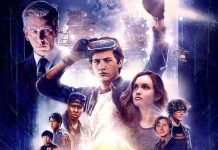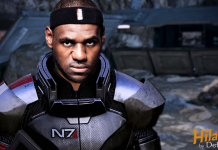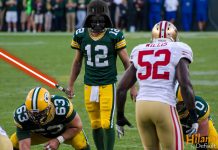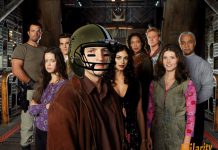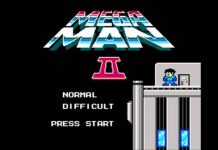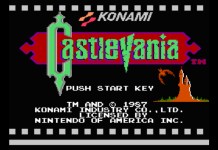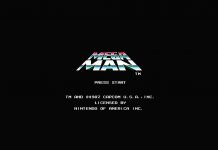There are several other items that can be picked up, though some are so rare that you’ll only see them once or twice in the entire game. As previously stated, Spiritual Strength allows Ryu to use his sub-weapons. These icons are scattered about the stages in destructible items. There’s also the Time Freeze item, which is exactly what it sounds like. Next up are the Bonus jars that grant either 500 or 1,000 additional points depending on whether you find a blue or red one. Lastly are the two rarest and most sought after items in the game… the Physical Strength urn that restores lost health and the 1-Up. I can’t begin to guess why these items are so rare, but I suppose it adds to the charm of the overall game.
That brings us to the topic of movement. The D-Pad obviously controls Ryu’s movement, allowing him to move left, right, and crouch. The A Button makes him jump and the B Button makes him slash with his sword. Holding the Up Arrow and pressing the B Button makes Ryu unleash whichever sub-weapon or ninpō he’s currently equipped with. Now then, just as in Castlevania, Ryu suffers from major knock back after taking a hit that can put him right in line to take several hits all in a row. This can lead to being knocked off a platform right into an instant kill pit, but wait! Wait just one second, because our hero is equipped with one final ability!
In addition to the slew of weapons and ninpō, Ryu also has the unique ability to cling to walls. This makes moving from platform to platform easier… y’know, so long as you don’t miss the wall by even a centimeter. The ninja can flip up and grab onto a nearby wall, then ascend by bouncing back and forth to a nearby adjacent wall. If Ryu takes a hit from an enemy and is sent plummeting into a pit, he can sometimes grab onto a wall, giving you an opportunity to work your way back up. Unfortunately, you’re also completely defenseless while climbing, so it leaves you exposed to whichever enemy knocked you into that pit to begin with, sooooooooooo yeah…
Question… how many of you know the story behind the original Super Mario Bros.? By now, everyone knows the story thanks to later entries in the series, the internet, and word of mouth, but back in 1985 the only way we found the true reason an Italian plumber in red overalls was stomping turtles, breaking blocks, and interminably finding his princess in another castle was by reading the instruction manual. In fact, that was the case with many games. The narrative was rarely, if ever, conveyed in-game. Well, Tecmo decided they were going to change all of that with its “Tecmo Theater,” wherein players are treated to highly detailed anime-esque cinematics and scrolling text. These cinematic cut scenes played after the player pressed start and at the end of each stage in order to convey the depth and complexity the series is known for.
While it is true that 1980’s Pac-Man was the first game to feature cut scenes and 1983’s Bega’s Battle was the first to use full-motion video for their cut scenes, Ninja Gaiden conveyed the story in a unique way that caught the eye and made you want to play on. They were more than just a reward for completing the stage, they were an essential puzzle piece to understanding why a ninja was slicing and dicing his way through New York City, being blackmailed by the CIA, searching for two mysterious statues, fighting against a deadly cult, suddenly battling horrific 1980’s movie monsters, and challenging an ancient demon.
So with the advent of these incredible cut scenes, I suppose we should speak about the game’s story, and what a tale it has to tell. It all begins with a cut scene in which a red ninja, revealed to be Ryu’s father Ken, is killed in a duel with an unknown opponent, later revealed to be Bloody Malth. Ryu receives a letter from his father (named Joe in the original Japanese Version), saying farewell and to seek out Walter Smith, an archaeologist in America. Vowing to avenge his father’s death, Ryu straps on the Dragon Sword and sets off for the U.S.A., and enters a world of intrigue, oddity, and sinister evil.
I’d like to take just a moment to point out the Ryu and Ken relationship seen here. While the names are better known for their legendary counterparts in the Street Fighter series, I couldn’t find any evidence that the name change was done as any kind of tribute. This is due to the fact that the first Street Fighter game had only been released in 1987 and despite being well-received, it was forgettable and far from the gaming powerhouse that Street Fighter II would become in 1991. At best, I feel that one of the translators may have been a fan, but I digress.
Upon landing in the U.S., most likely La Guardia as the first stage appears to be New York City, Ryu finds himself beset by a gang of bikers, thugs in wife beaters that throw knives, wannabe boxers, and dogs. He also has to contend with the first member of the Malice Four, The Barbarian. This boss seems oddly out of place, but then again, compared to the drastic turn the game takes in Act 4, a medieval executioner in steel armor isn’t all that out there. Upon defeating the first boss, players are treated to a new cut scene that introduces Irene Lew, a sexy CIA operative that becomes a love interest for Ryu… she also shoots and drags him off to a secret prison, but that’s beside the point.
Awakening, Ryu finds Irene watching over him. She sets him free, gives him the “Shadow Demon” statue, and points him towards the exit, which just happens to be through another swarm of gang members. As our valiant hero slashes his way through to freedom, he finds that there are new henchman popping up; heavily armed soldiers, suicidal infantry men, machete wielding commandos, and the most out of place henchman yet, a green skinned ghoul wrapped in a purple cloak that throws wooden crosses. No, I’m not making that up. Making his way out of the prison, Ryu is confronted by the second member of the Malice Four, Bomberhead. Laughable name aside, he’s actually a pretty well designed boss, so long as spiked leather coats and bracelets are your thing. This large black biker hides his face behind a gladiatorial mask and wields a chain and sickle (or kusarigama for sticklers).
Finally making contact with Walter Smith, we learn that the “Shadow” statue has a companion, the “Light Demon” statue (which makes no sense to me, but hey…) and reveals that he and Ken had found the statues in the Amazon many years ago. He also explains that the statues contain the power of an ancient demon named Jashin, but before he can go on, the third member of the Malice Four, Basaquer, breaks in and steals one of the statues. Giving chase, Ryu finds himself surrounded by dozens of heavily armed men. The soldiers from the previous Act are joined by snipers, panthers, and the bane of my Ninja Gaiden experience… the birds. As if they were taken directly from the Alfred Hitchcock film, these birds are relentless in their pursuit of Ryu’s eyes, fingers, and fleshy bits. Medusa Heads in Castlevania can’t even begin to hold a candle to the irritation, aggravation, and downright infuriation of these frigging things…






